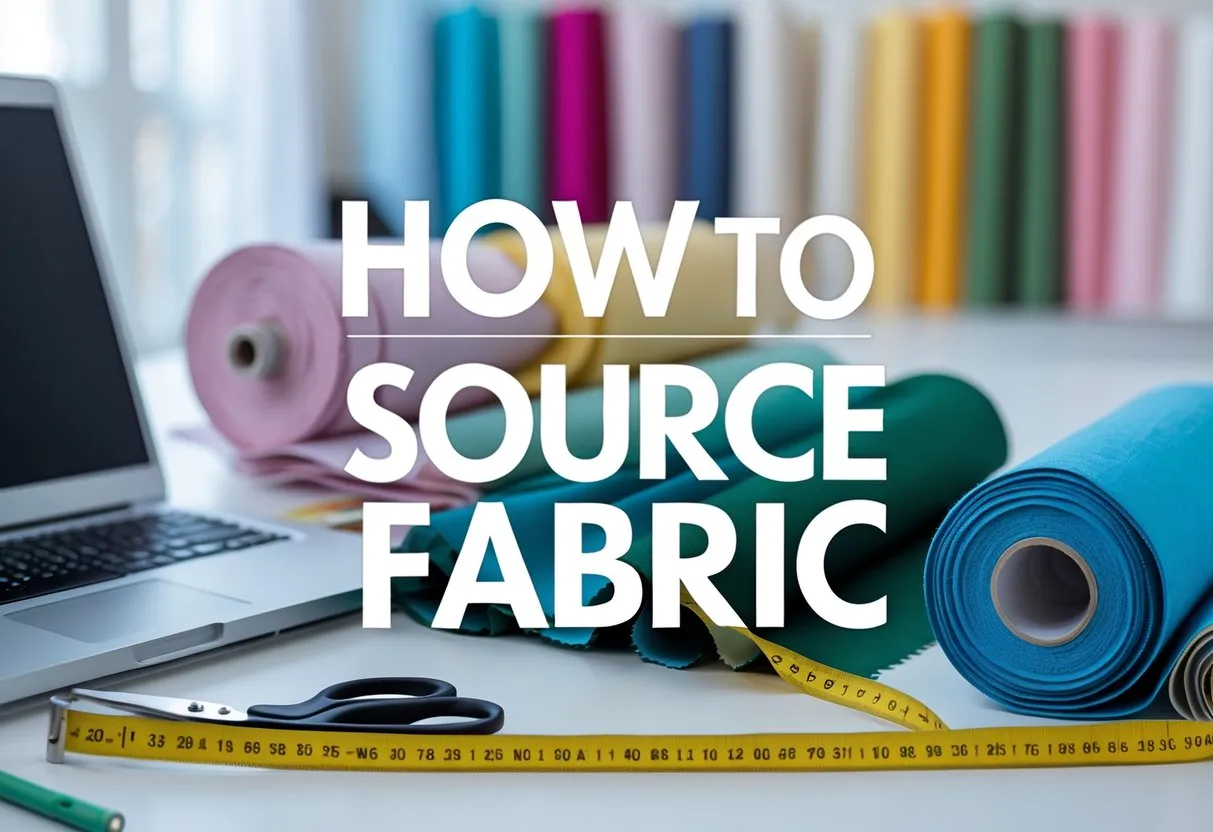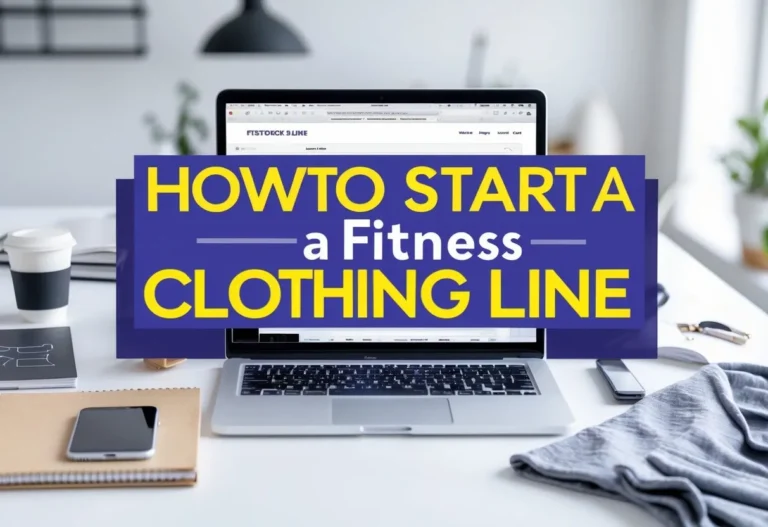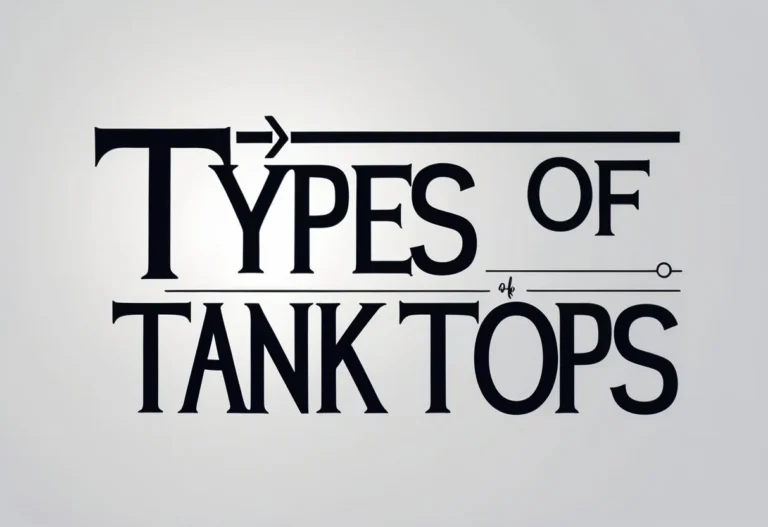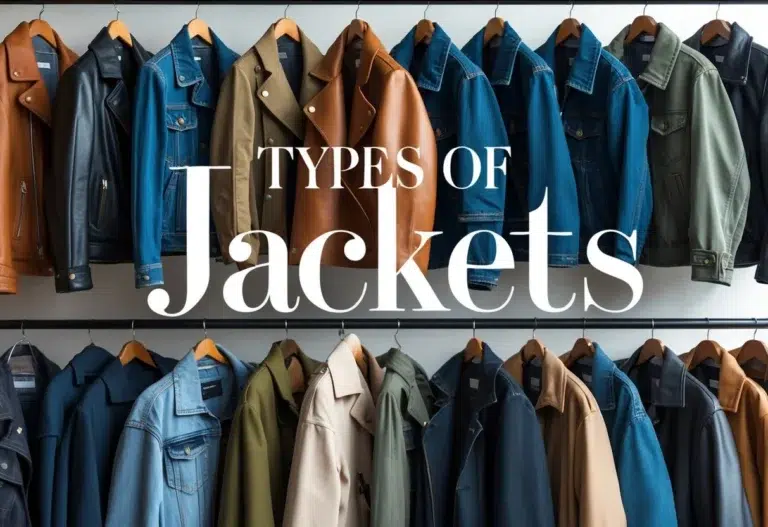How To Source Fabric For Clothing Line: Suppliers & Quality
How To Source Fabric For Clothing requires careful attention to fabric sourcing, as the quality and type of fabric directly affect the final product’s look, feel, and durability. Choosing the right fabric involves understanding different materials, construction methods, and supplier options to ensure the product meets customer expectations and production needs. Fabric sourcing is a crucial step that shapes the success and reputation of any clothing brand.

It’s important to know where to find reliable fabric suppliers and how to assess fabric quality through samples before committing to large orders. Managing costs, minimum order quantities, and delivery times also plays a key role in maintaining efficient production schedules and budget control. By mastering these areas, designers can build a strong foundation for their clothing lines.
Exploring sustainable and ethical fabric options is increasingly relevant for brands wanting to meet consumer demand and industry standards. Successful fabric sourcing combines strategic planning with thorough research and negotiation to deliver materials that fit a brand’s vision and market needs.
Table of Contents
Key Takeaways
- Knowing fabric types and supplier options is essential for a quality clothing line.
- Reviewing fabric samples and managing costs helps control production success.
- Sustainable sourcing supports brand values and meets growing market demand.
Clarifying Fabric Needs for Your Clothing Line
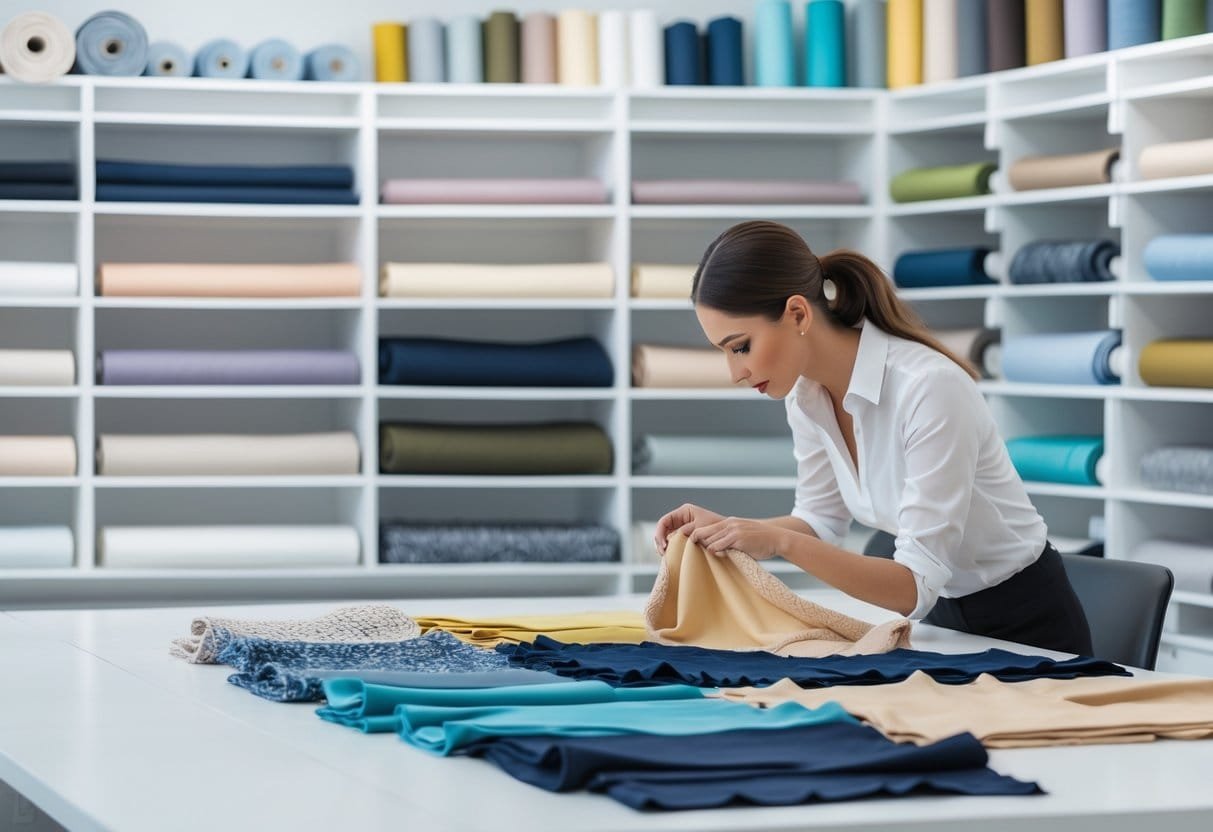
Understanding fabric needs is key to designing garments that meet both quality standards and customer expectations. Carefully assessing the intended use, fabric properties, and target audience helps fashion designers select materials that enhance their clothing line’s appeal and performance.
Identifying End Use and Garment Requirements
Fashion designers must first define the specific function of each garment. Casual wear, activewear, formal clothing, and outerwear each have distinct fabric needs. For example, activewear requires stretchy, moisture-wicking fabrics that offer comfort and durability. Formal wear often demands fabrics with a smooth drape and elegant finish, like satin or fine wool.
Considering factors like seasonality, garment fit, and required durability will guide the fabric choice. For prototypes, designers often test different fabric samples to ensure the material supports the garment’s structure and look. Fabric weight, elasticity, and care instructions should align with the intended everyday wear and maintenance of the final product.
Determining Fabric Qualities and Performance
Fabric selection goes beyond appearance. The textile’s construction and fiber content affect qualities such as breathability, stretch, wrinkle resistance, and shrinkage. Knitted fabrics usually provide stretch and softness, suitable for tops or undergarments, while woven fabrics offer strength and structure needed for pants and jackets.
Performance qualities like abrasion resistance and colorfastness matter, especially for frequently worn or washed items. Designers should ask suppliers about these technical specifications and test swatches before bulk orders. Proper fabric choice can improve garment longevity and customer satisfaction by preventing common issues like pilling or fading.
Understanding Target Market and Consumer Expectations
A clothing line’s success depends on meeting the preferences and needs of its customers. Designers should analyze their target market’s lifestyle, climate, and style trends. For instance, sustainable fibers may attract eco-conscious buyers, while budget shoppers might prioritize affordable, easy-care fabrics.
Consumer expectations also influence fabric selection regarding feel, durability, and price point. Conducting research or surveys helps designers understand these preferences. Knowing how customers intend to wear and care for the garments shapes fabric sourcing decisions and ensures alignment with brand values and market demands.
Understanding Types and Construction of Fabrics
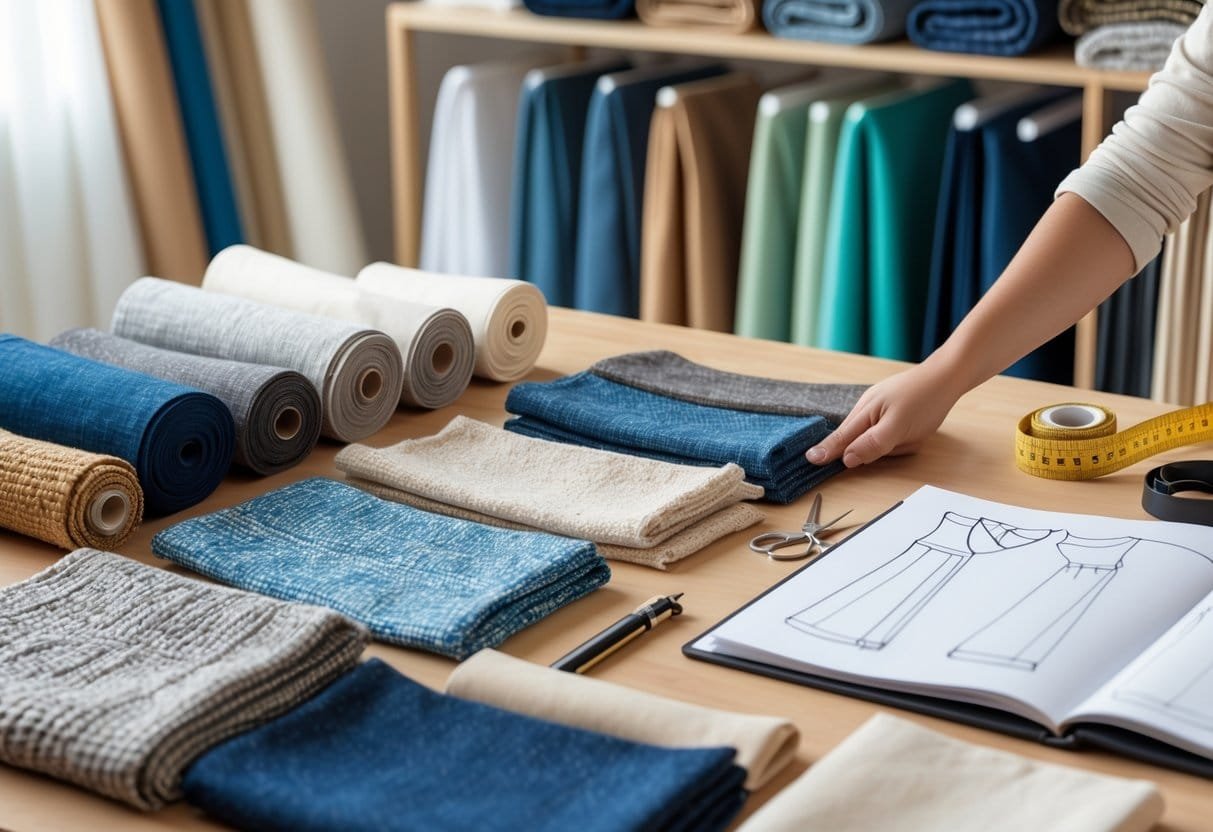
Choosing the right fabric starts with knowing the different fiber types and how fabrics are made. The feel, durability, and care of a garment depend heavily on these factors. Fabric structure, fiber origin, and weaving style all influence the final product’s quality and suitability.
Natural Fibers: Cotton, Linen, and Others
Natural fibers come from plants, animals, or minerals. Cotton and linen are two common natural fibers widely used in fashion fabric. Cotton is soft, breathable, and durable, making it ideal for everyday clothing like t-shirts and jeans. Linen, made from flax, is lighter and has a distinct texture. It’s great for warm-weather garments because of its breathability.
Other natural fibers include wool from sheep, silk from silkworms, and hemp. These fabrics tend to be more sustainable but may need special care. Natural fibers usually allow good airflow and absorb moisture, making garments comfortable to wear.
Synthetic Fibers: Polyester, Nylon, and Blends
Synthetic fibers are man-made, often from petrochemicals. Polyester and nylon are the most common synthetic fibers found in fashion fabric. Polyester is strong, resistant to wrinkles and shrinking, and dries quickly. It is often blended with natural fibers to increase durability and reduce costs.
Nylon is known for its elasticity and abrasion resistance, frequently used in activewear and outerwear. Synthetic fabrics generally require less maintenance and are less prone to fading. However, they might not breathe as well as natural fabrics, so designers must consider the end-use of the garment when choosing these fibers.
Knit Fabrics vs Woven Fabrics
Fabric construction falls mainly into two categories: knits and wovens. Knit fabrics are made by looping yarns together, creating a stretchy, soft fabric. This elasticity makes knits popular for t-shirts, underwear, and sportswear since they move with the body and resist wrinkles.
Woven fabrics involve interlacing two sets of yarns at right angles. This construction leads to a generally stronger, less stretchy fabric. Wovens are common in tailored clothing like dress shirts, pants, and jackets. They provide good structure and durability but wrinkle more easily than knits.
Fabric Construction and Weaves
Fabric construction includes how yarns combine and the weave pattern used. Woven fabrics often use simple or complex weaves. Common simple weaves include:
- Plain weave: Yarn goes over and under alternately; used in cotton shirts.
- Twill weave: Diagonal lines on fabric; seen in denim and chinos.
- Satin weave: Smooth surface with a shiny finish; often in evening wear.
Complex weaves like jacquard create patterns within the fabric itself. The weave affects texture, strength, and drape. Knowing the weave helps predict fabric behavior for different clothing needs, such as whether a fabric is stiff or flows smoothly on the body.
Researching and Sourcing Quality Fabrics

Finding quality fabric is key for any clothing line. It requires knowing where to look, understanding supplier types, and choosing the best options for design and budget. Different routes offer varied fabric selections, prices, and order minimums. Careful research helps avoid delays and ensures the materials meet required standards.
Sourcing from Fabric Mills, Wholesalers, and Jobbers
Fabric mills produce the raw fabric and usually require minimum orders, often in large quantities. They offer the highest control over fabric quality and customization but may not suit smaller brands due to high minimum order quantities (MOQs).
Wholesalers buy in bulk from mills and sell smaller amounts. They provide easier access to stock and can offer a wider range of fabrics. Some wholesalers specialize in specific fabric types, helping brands find what fits their needs without large commitments.
Jobbers sell leftover or discontinued fabric from mills and converters at reduced prices. They often carry limited stock, which means the exact fabric may not be available later. Jobbers can be useful for sampling or limited runs, but brands should be cautious about relying on them long term.
Using Online Marketplaces and Local Fabric Stores
Online marketplaces like Alibaba and Faire connect clothing brands to global fabric suppliers. They offer wide variety and ease of browsing catalogs from home. Ordering fabric samples or swatches online helps evaluate quality before bulk purchases.
Local fabric stores provide hands-on access to materials. Designers can see and feel fabrics immediately and avoid shipping delays. Although stores often have smaller selections and higher prices, they serve well for quick prototypes and testing fabric feel in person.
Both online and local sources play important roles. Online markets tend to offer scale and variety, while local stores provide immediate physical inspection and support smaller quantities.
Attending Trade Shows and Fabric Fairs
Trade shows such as Texworld or The Fabric Shows gather many fabric mills, wholesalers, and vendors in one place. These events offer exposure to new fabrics, trends, and suppliers.
Visiting fabric fairs allows designers to touch fabrics, discuss details directly with suppliers, and negotiate pricing face-to-face. Buyers often discover exclusive fabrics not widely available online or in stores.
Preparation is critical. Research exhibitors to target specific fabric mills or wholesalers beforehand. Time management helps cover important booths and avoid overwhelming experiences. Trade shows remain invaluable for building supplier relationships and sourcing unique fabrics.
Leveraging Fabric Sourcing Agents and Vendors
Fabric sourcing agents act as intermediaries who find materials matching specific brand needs. They have industry contacts and negotiate prices and order terms. Agents help manage communication with foreign mills and vendors, reducing language and logistical challenges.
Using vendors with in-depth knowledge of fabric production can streamline sourcing. These pros ensure fabric quality meets requirements and delivery times align with production schedules.
Sourcing agents and vendors are especially valuable for brands new to fabric procurement or seeking complex fabrics. They save time and reduce risk but usually charge fees or commissions for their services.
Evaluating Fabric Samples and Quality Assurance
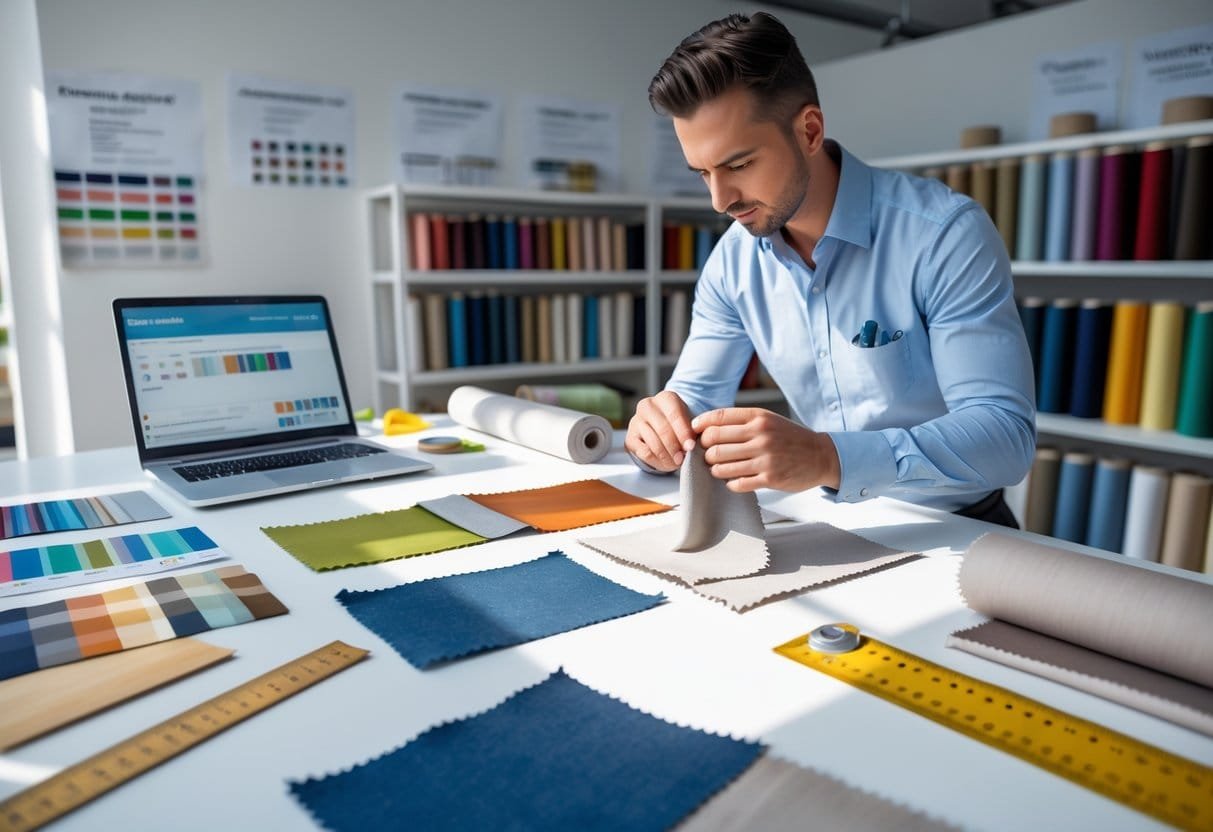
Evaluating fabric samples carefully is key in selecting the right material for a clothing line. This process involves more than just looking at how the fabric feels or looks. It requires checking its durability, color stability, and verifying certifications to ensure the fabric meets quality and safety standards.
Requesting and Assessing Fabric Swatches
Requesting fabric swatches gives an initial chance to examine the material. Swatches represent a small piece of the fabric source and help assess texture, weight, and print accuracy.
When assessing swatches, attention should focus on the fabric weight, which affects the garment’s drape and feel. Checking the fabric’s weave and finish helps spot inconsistencies like uneven dyeing or defects common in greige goods. A tactile inspection is important to understand softness and stretch.
Small-scale testing on swatches can help catch fabric flaws early. Comparing swatches from different suppliers also clarifies which fabric best fits the clothing design and target market.
Testing for Durability, Colorfastness, and Shrinkage
Durability tests measure how well the fabric holds up to stress, wear, and repeated use. Important tests include breaking strength and tear resistance, which simulate real-life fabric tension.
Colorfastness testing checks if the fabric retains its color under washing, rubbing, exposure to light, and perspiration. Poor colorfastness can result in fading or stains on other materials during wear or care.
Shrinkage tests reveal how much the fabric will reduce in size after washing. This is critical for sizing accuracy and garment fit. Shrinkage should be minimal or accounted for in production.
Laboratories or trusted inspection services often conduct these tests to deliver reliable, standardized results that help manufacturers avoid costly errors.
Reviewing Certifications and Compliance
Certifications attest to fabric quality and safety, supporting responsible fabric sourcing. Common standards include GOTS (Global Organic Textile Standard), which ensures fabric is organic and processed sustainably.
Oeko-Tex certification ensures textiles are free from harmful chemicals. It is often essential for brands focusing on eco-friendly materials.
Suppliers with these certificates demonstrate compliance with strict environmental and safety regulations. Confirming certifications helps reduce risks linked to material toxicity, ethical concerns, and legal issues. It also appeals to consumers seeking sustainable products.
Thorough document checks during sourcing guard against counterfeit claims and verify that the fabric meets all required norms for a clothing line.
Cost, MOQ, and Supplier Negotiation Strategies

Sourcing fabric requires careful attention to budget limits, order sizes, and building strong ties with suppliers. By understanding costs, the impact of minimum order quantities, and how to negotiate effectively, fashion designers can secure better deals and maintain control over their inventory and cash flow.
Managing Fabric Costs and Budgeting
Fabric cost is a major factor for clothing lines. Designers should calculate the total cost per yard or meter and include shipping, taxes, and possible import fees. Comparing prices from multiple suppliers helps find the best value without sacrificing quality.
Budgeting must factor in potential price changes and hidden fees. Bulk orders often reduce the cost per yard, but this must be balanced against storage and upfront payment risks. Tracking fabric usage per style helps estimate the needed quantity accurately.
Using samples before large orders can prevent costly mistakes. Designers should also explore sustainable or alternative fabrics which might lower long-term costs.
Understanding Minimum Order Quantity (MOQ) Requirements
MOQs define the smallest amount of fabric a supplier will sell. These are set to balance production efficiency and supplier risk. High MOQs may force designers to buy more fabric than needed, creating excess inventory and cash flow strain.
Fashion designers new to sourcing often face challenges with large MOQs, limiting flexibility to test designs or enter new markets. Suppliers usually prefer higher MOQs to cover setup costs and keep production lines efficient.
Knowing why MOQs exist allows designers to plan orders better. Sometimes, MOQs can be negotiated or lowered by demonstrating future buying potential or sharing setup costs. Clear communication about the brand’s growth helps suppliers see long-term benefits.
Negotiating Supplier Terms and Relationships
Strong supplier relationships are key to better terms. Designers should prioritize open communication and trust. Starting with smaller trial orders invites suppliers to test the partnership without a large commitment.
Negotiation tactics include offering flexible payment terms like deposits or faster payments. Presenting sales projections and market data often persuades suppliers to reduce MOQs.
Sharing production costs or agreeing to increase orders later can make suppliers more willing to lower initial demands. Using sourcing agents or local contacts can ease cultural and language differences, improving negotiation success.
Being prepared to walk away if terms don’t match needs also strengthens a designer’s position. Keeping negotiations professional and focused on mutual benefits leads to better, lasting agreements.
Sustainable and Eco-Friendly Fabric Sourcing

Sourcing fabric with sustainability in mind involves choosing materials and suppliers that reduce environmental harm and support ethical practices. It requires understanding fabric types, certifications, and how supply chains operate to ensure transparency and responsibility.
Identifying Sustainable Fabric Options
Sustainable fabrics include materials with lower environmental footprints. Common choices are organic cotton, which uses less water and no synthetic pesticides, and recycled polyester, made from reused plastic bottles, reducing landfill waste. Other options like TENCEL™ and hemp are made from rapidly renewable resources and often require fewer chemicals.
Choosing between natural and synthetic sustainable fabrics depends on the brand’s goals for feel, durability, and eco-impact. Brands should order samples to test quality alongside sustainability claims. Considering a fabric’s full lifecycle—from farming or production to disposal—is essential for true sustainability.
Certifications and Environmental Impact
Certifications help verify sustainable fabric claims. The Global Organic Textile Standard (GOTS) ensures organic farming, prohibits toxic chemicals, and requires fair working conditions. OEKO-TEX® certifies fabrics free of harmful substances but does not cover organic status.
Brands should look for these certifications on supplier documents to confirm environmental and social standards. Understanding terms like water usage, energy consumption, and carbon footprint in fabric production helps in evaluating the fabric’s true impact beyond just being labeled eco-friendly.
Working with Sustainable Supply Chains
Sourcing sustainably means partnering with suppliers committed to transparency and ethical practices. This includes verifying fair wages, safe working conditions, and environmental management systems.
Brands can reduce risk by choosing mills with traceable supply chains and clear documentation. Strong communication and clear contracts help maintain sustainability standards throughout production. Supporting near-shore or regional suppliers can also reduce transport emissions and improve delivery reliability.
Managing Logistics and Delivery

Efficient management of fabric delivery involves careful planning of schedules and handling potential risks during shipping. Timely coordination ensures prototypes and bulk fabric arrive when needed, which keeps production on track and within budget.
Coordinating Fabric Delivery Schedules
Scheduling fabric delivery means aligning arrival times with design and production phases. Early communication with suppliers is key to confirm lead times, especially for prototypes and sample yardage. Suppliers often have different lead times for sample versus bulk orders, so tracking both is essential.
Delays in fabric delivery can halt the sourcing process and slow garment development. Setting clear deadlines and buffer periods helps manage unexpected issues. Using order tracking tools or a supply chain dashboard supports visibility over shipment status.
It’s important to confirm if fabrics will be delivered in full or in partial shipments. Partial deliveries may allow starting prototype work earlier but require precise inventory management to avoid confusion on quantities and timing.
Handling Shipping, Customs, and Supply Chain Risks
Shipping fabric internationally involves navigating customs regulations and tariffs that can affect delivery time and cost. Accurate paperwork and consistent communication with freight forwarders reduce delays.
Supply chain risks include port congestion, natural disasters, or factory shutdowns. Maintaining relationships with multiple suppliers and having contingency plans like alternative shipping routes helps reduce these risks.
Transparency about where fabric originates and its journey through the supply chain is critical. This not only aids customs clearance but also supports sustainability claims and ethical sourcing verification.
Fabric damage during shipping is a concern. Proper packaging and insurance should be arranged with suppliers to protect both sample and bulk yardage shipments.
Frequently Asked Questions
How To Source Fabric For Clothing involves balancing quality, cost, and delivery timelines while choosing the right partners. It also requires understanding supplier types and using events or digital tools to find the best materials. Sustainability and supply chain integration play important roles in decision-making as well.
What are the most effective strategies for sourcing fabric for a new clothing line?
The first step is learning about fabric construction and types to match material with design needs. Building relationships with suppliers and ordering fabric samples help ensure quality. Starting with small or low minimum orders reduces risk. Using trade shows and online platforms expands options.
How do clothing companies identify and choose the right fabric suppliers?
Companies look for suppliers that offer consistent stock, clear communication, and reliable delivery times. They often compare mills, converters, and jobbers by reviewing product specs like fabric weight, content, and width. Testing samples and confirming minimum order quantities are key steps. Trust and previous performance are major factors in final decisions.
What are the advantages of attending fabric sourcing trade shows for apparel businesses?
Trade shows give buyers a chance to see and feel hundreds of fabric options in one place. Direct contact with suppliers speeds up negotiations and clarifies technical questions. It also offers opportunities to discover new, trending materials and build personal connections that can improve future orders.
Could you explain the role of fabric sourcing in a clothing line’s supply chain management?
Fabric sourcing sets the foundation for manufacturing timelines and product quality. Choosing dependable suppliers helps avoid production delays and ensures material consistency. Managing lead times, costs, and minimum order requirements directly impacts overall supply chain efficiency and inventory control.
What are the key considerations when sourcing eco-friendly and sustainable fabrics?
Focus on materials like organic cotton, Tencel, or recycled fibers that reduce environmental impact. Verify supplier certifications and production methods to ensure true sustainability. Price, availability, and fabric performance should still meet design needs while supporting responsible practices.
How does one navigate online fabric sourcing, and what best practices should be adopted?
Review detailed fabric descriptions and request sample swatches to check feel and quality. Use trusted platforms and buyer reviews to vet suppliers. Pay attention to order minimums, delivery times, and return policies. Keeping clear communication and documenting specifications helps avoid mistakes in remote purchasing.

